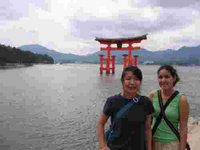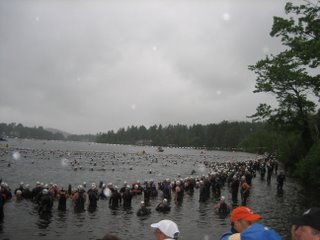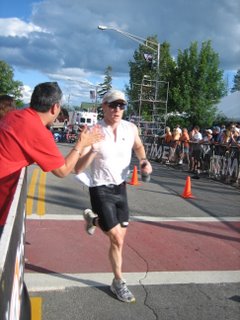Our host for the summer, H, took V and I sightseeing this weekend. This meant he spent his precious days of rest carting us around in his Mazda station wagon.
Kurashiki

On Saturday, we went to Kurashiki. Kurashiki means "warehouse village," and its claim to fame are warehouses made with special black tile and white mortar pattern that can be found on the bottom of all the old buildings.
We first went into the Ohara Art Museum. Mainly a collection of European paintings, in the adjoining buildings you can see a collection of folk art, and modern Japanese paintings. The main tourist attraction is the Bikan area, which encompasses a preserved walkway along both sides of a small river. The walkway is lined with small curio shops.
In these stores, you can find lots of souvenirs with a boy wearing a white

headband. Okoyama prefecture is the home of Momotaro, "Peach Boy." This story is
uniquely Japanese fairy tale. As the story goes, an old couple who had no child find a peach floating down the river. Before they can cut it to eat it, boy springs out of it. They adopt him, and when he is a teenager he leaves home to go fight demons on a far off island. He befriends a dog, monkey, and pheasant by giving them some millet sweet dumplings. The four of them defeat the three-eyed demon, bring home treasure and live happily ever after.
MiyajimaMiyajima is a small island in the Inland Sea. It about an hour drive from

Hiroshima, and then 10 minute ferry ride. The Ohtorii (Gate) in the harbor is a must see monument. The Itsukushima shrine is a maze of orange pillars that sits only a few feet from the shore. According to H, this temple is destroyed time and time again by typhoons. The original shrine was built in 593, by some famous samurai, but what we see today is a reconstructed reconstruction of an interpretation of the original shrine. Despite my cynicism the shrine and the gate were awesome.
Besides the shrine and the gate, Miyajima is known for its wildlife, deer and monkeys to be specific. Right outside the ferry station, a man with a cart sells deer food. The deer have no fear of people and happily walk all around the town. In this case, the teenager in the green is getting attacked by the deer for the deer biscuits he is holding over his head.

Having taken a gondola to the top of Mt. Misen, we saw the following sign, that warns visitors to not stare at the monkeys eye to eye; do not feed the monkeys, and the monkeys will steal all your belongings. The gondola company also warns that all tickets eaten by deer or monkeys will not be reissued.

We did not get to see any monkeys, but the cool breeze on top of the mountain was a welcome surprise. From the mountain, we had a panoramic view of many small islands. On a clear day, you can see Shikoku, the smallest of the 4 major Japanese islands. From a distance Hiroshima appeared to be a truly large city.
Yamaguchi
The last sightseeing stop was in the Yamaguchi prefecture to see the Kintai Bridge. It has five arches and according to legend only samurai were allowed to cross it. Today for 300 yen, one can pretend to be a samurai and cross the wooden bridge.
For dinner, H took V and I to a place roughly translated to "the Bandit's Lair." It is a theme restaurant hidden in the mountains. When we drove up to it, we all could help saying "oh my goodness." (Hanging around H has diminished V's and my English verbal skills.) There were brightly colored oversized paper lanterns hanging above the parking lot. The restaurant itself was a multi-room  compound. Large cutouts that you could put your face in to pretend you were a bandit stood at the entrance. Children beat the drums by the cutouts. The food was bandit food, naturally. Bandits apparently ate with their hands a lot because we ordered the house specialties of large rice balls wrapped in nori and chicken roasted on a stick. Every other table had ordered the same things.
compound. Large cutouts that you could put your face in to pretend you were a bandit stood at the entrance. Children beat the drums by the cutouts. The food was bandit food, naturally. Bandits apparently ate with their hands a lot because we ordered the house specialties of large rice balls wrapped in nori and chicken roasted on a stick. Every other table had ordered the same things.
 BF and I took a road trip last weekend to Wilmington, NY, which is about 20 minutes east of Lake Placid, both of which are in the Adirondacks. BF's ex-coworker/room mate was swimming/biking/running the Ironman Triathlon on Sunday. I knew that the Ironman involved running a marathon, but I didn't know what the distances for the other events were. For the similarly uninformed, here they are: swim 2.4 miles, bike 112 miles, and then finish by running 26.2 miles. After the swim (1:23:26), DF was around 1700 in the overall standings. He climbed to about 700 after the bike (5:53:49) and then to 440 after the marathon (4:00:12!). He finished in 11 hours and 27 minutes.
BF and I took a road trip last weekend to Wilmington, NY, which is about 20 minutes east of Lake Placid, both of which are in the Adirondacks. BF's ex-coworker/room mate was swimming/biking/running the Ironman Triathlon on Sunday. I knew that the Ironman involved running a marathon, but I didn't know what the distances for the other events were. For the similarly uninformed, here they are: swim 2.4 miles, bike 112 miles, and then finish by running 26.2 miles. After the swim (1:23:26), DF was around 1700 in the overall standings. He climbed to about 700 after the bike (5:53:49) and then to 440 after the marathon (4:00:12!). He finished in 11 hours and 27 minutes.  7:00 am, but the roads closed at 6:00 am, which meant waking up at 4:30 am so that we could grab breakfast and find parking. We then spent 11 hours (a) standing in the rain, (b) taking cover in Jack Frost's restaurant where they kicked us out after we finished our third cup of coffee, (c) napping by the lake after the rain finally stopped, (d) trying to find shade once the sun finally came out, (e) cheering DF on as he whizzed by on his bike and sprinted along on foot, and (f) eating ice cream, pringles, and many cups of coffee. I think the only thing that I have ever done for over 11 hours is sleep. By then end of it, I was EXHAUSTED! I can only imagine how DF felt...
7:00 am, but the roads closed at 6:00 am, which meant waking up at 4:30 am so that we could grab breakfast and find parking. We then spent 11 hours (a) standing in the rain, (b) taking cover in Jack Frost's restaurant where they kicked us out after we finished our third cup of coffee, (c) napping by the lake after the rain finally stopped, (d) trying to find shade once the sun finally came out, (e) cheering DF on as he whizzed by on his bike and sprinted along on foot, and (f) eating ice cream, pringles, and many cups of coffee. I think the only thing that I have ever done for over 11 hours is sleep. By then end of it, I was EXHAUSTED! I can only imagine how DF felt... 







